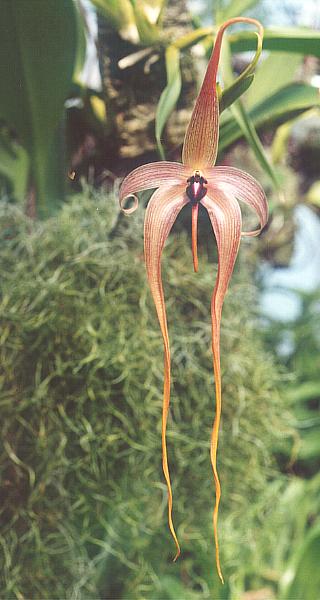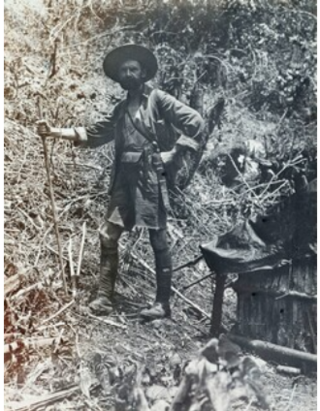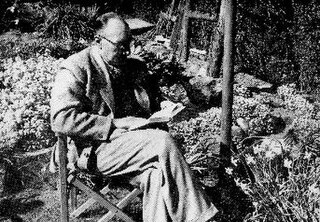
Orchids are plants that belong to the family Orchidaceae, a diverse and widespread group of flowering plants with blooms that are often colourful and fragrant. Orchids are cosmopolitan plants that are found in almost every habitat on Earth except glaciers. The world's richest diversity of orchid genera and species is found in the tropics.

Bulbophyllum is a genus of mostly epiphytic and lithophytic orchids in the family Orchidaceae. It is the largest genus in the orchid family and one of the largest genera of flowering plants with more than 2,000 species, exceeded in number only by Astragalus. These orchids are found in diverse habitats throughout most of the warmer parts of the world including Africa, southern Asia, Latin America, the West Indies, and various islands in the Indian and Pacific Oceans. Orchids in this genus have thread-like or fibrous roots that creep over the surface of trees or rocks or hang from branches. The stem is divided into a rhizome and a pseudobulb, a feature that distinguished this genus from Dendrobium. There is usually only a single leaf at the top of the pseudobulb and from one to many flowers are arranged along an unbranched flowering stem that arises from the base of the pseudobulb. Several attempts have been made to separate Bulbophyllum into smaller genera, but most have not been accepted by the World Checklist of Selected Plant Families.

The Royal Asiatic Society of Great Britain and Ireland, commonly known as the Royal Asiatic Society, was established, according to its royal charter of 11 August 1824, to further "the investigation of subjects connected with and for the encouragement of science, literature and the arts in relation to Asia." From its incorporation the society has been a forum, through lectures, its journal, and other publications, for scholarship relating to Asian culture and society of the highest level. It is the United Kingdom's senior learned society in the field of Asian studies. Fellows of the society are elected regularly and include highly accomplished and notable scholars of Asian studies; they use the post-nominal letters FRAS.

Henry Nicholas Ridley CMG (1911), MA (Oxon), FRS, FLS, F.R.H.S. was an English botanist, geologist and naturalist who lived much of his life in Singapore. He was instrumental in promoting rubber trees in the Malay Peninsula and, for the fervour with which he pursued it, came to be known as "Mad Ridley".

Cecil Boden Kloss was an English zoologist. He was an expert on the mammals and birds of Southeast Asia. The Rubiaceae genus Klossia was named after him.
The Journal of the Malaysian Branch of the Royal Asiatic Society (JMBRAS) is a scholarly journal published by the Malaysian Branch of the Royal Asiatic Society (MBRAS). The journal covers topics of historical interest concerning Peninsular Malaysia, Sabah, Sarawak, Labuan and Singapore. It was founded in 1877 in Singapore.
Michael Willmer Forbes Tweedie was a naturalist and archaeologist working in South East Asia, who was Director of the Raffles Museum in Singapore.
Bulbophyllum cylindricum is a species of orchid in the genus Bulbophyllum found in Sikkim.
Bulbophyllum evasum, commonly known as the creeping brittle orchid, is a species of epiphytic or lithophytic orchid with creeping brittle rhizomes, small, stubby pseudobulbs and dark green, fleshy leaves. The flowers are small, pink to reddish with dark stripes and yellow tips, clustered on the end of a dark red flowering stem. This orchid grows in rainforest on tree trunks and branches as well as on rocks, in tropical North Queensland.

Bulbophyllum exiguum, commonly known as the tiny strand orchid, is a species of epiphytic or lithophytic orchid that is endemic to eastern Australia. It has small, roughly spherical pseudobulbs each with a single leaf and up to three small creamy white to yellow flowers emerging from the base of the pseudobulb. This orchid grows in rainforest and dry forest where it often covers the branches of trees or rocks on which it grows.

Bulbophyllum gadgarrense, commonly known as the tangled rope orchid, is a species of epiphytic orchid with small pseudobulbs hidden beneath purplish brown bracts, dark green, grooved leaves and small white flowers with orange or yellow tips. It grows on rainforest trees in tropical North Queensland.

Bulbophyllum weinthalii, commonly known as the wax orchid, is a species of epiphytic orchid that forms dense clumps on hoop pine. It has crowded pseudobulbs each with a single thin, leathery, dark green leaf and a single white, green or cream-coloured flower with red or purplish markings. It occurs from south-eastern Queensland to Dorrigo National Park in New South Wales.

Murray Ross Henderson (1899–1982) was a Scottish botanist who did most of his botanical work in the Straits Settlements and South Africa. He took a position as a botanist in Malaya in 1921 and became curator of the herbarium in the Singapore Botanical Gardens in 1924.
Bulbophyllum nocturnum is a species of epiphytic orchid that grows in New Britain. It was described in 2011, and is the first species of orchid known to consistently flower during the night, and close its flowers during the day.

Dendrobieae is a tribe in the subfamily Epidendroideae, in the family Orchidaceae. The Dendrobieae are mostly tropical, epiphytic orchids which contain pseudobulbs.
Warren Delabere Barnes was a British colonial administrator.

Coelogyne exalata is an orchid endemic to Borneo.

Sir William Edward Maxwell, was a British colonial official who served as Colonial Secretary of the Straits Settlements and Governor of the Gold Coast, then a British colony.
The Malaysian Branch of the Royal Asiatic Society (MBRAS) is a learned society based in Kuala Lumpur, Malaysia.
Cedric Errol Carr was a New Zealand botanist, specialising in orchids. At the age of seven he went to England with his family but from January 1913 until 1931, apart from military service from 1916 to 1918, he worked on rubber plantations in Malaya.











